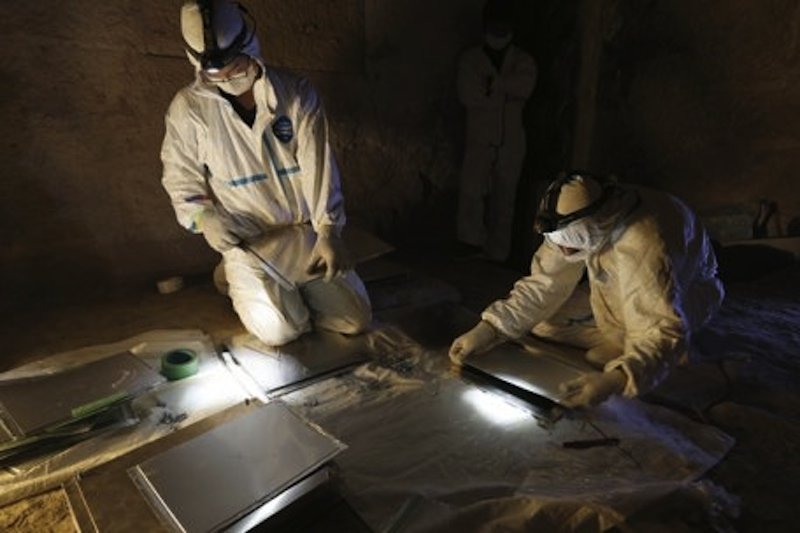
According to preliminary results, thermal "points of interest" were observed on the northern facade of the Great Pyramid at Giza, known as Khufu or Cheops, and on the west face of Red pyramid in Dahshur.
The announcement comes at the end of a three-month project to scan four pyramids which are more than 4,500 years old. They include the Great Pyramid, Khafre or Chephren at Giza, the Bent pyramid and the Red pyramid at Dahshur.
Scheduled to last one year, the project, called ScanPyramids, uses a mix of innovative technologies such as infrared thermography, muon radiography, and 3-D reconstruction to identify the presence of unknown internal structures and cavities.
It is carried out by a team from Cairo University's Faculty of Engineering and the Paris-based non-profit organization Heritage, Innovation and Preservation (HIP Institute) under the authority of the Egyptian Ministry of Antiquities.
"The primary result tells us that we have some good news," Antiquities Minister Mamduh al-Damati said at a news conference. "Although no discoveries have yet been made, scans have revealed several anomalies which indicate that a discovery could be made in the pyramids by the end of 2016."
Last November the researchers detected a striking thermal anomaly on the eastern side of the Great Pyramid at Giza, which could possibly indicate an unknown cavity or internal structure.
Further analysis of the thermal and infrared survey carried out in November has now revealed a similar anomaly on the northern side of the monument.
"We are not drawing any conclusions at the moment," Mehdi Tayoubi, co-director of the ScanPyramids mission with Hany Helal, professor at Cairo University's Faculty of Engineering and former minister of research and higher education, told Discovery News.
"This project is evolving in real time according to what happens on the field. Our goal is to inform step by step about all the actions we take," he added.
He said that a new step has been added in the infrared survey process begun in November.
"Because we need to confirm that the anomalies are still there in a long time period and because we need to make hypothesis and simulation, we are going to measure the temperatures during 24 hours for each phase," Tayoubi said.
The goal is to prepare a long term survey measurement so to eliminate natural factors, such as wind and changing seasons.
Another intriguing anomaly was detected on some of the limestone blocks that make up the western side of Red Pyramid in Dahshur.
"There is a clear difference of temperature, a cold and a hot zone, which is not found on the other sides. The bottom is colder than the top," Matthieu Klein of Canada's Laval University told reporters.
"It could be because of the wind ... We have no answers yet, that's why we need long time measurements and hypothesis simulations," he said.
The researchers will further investigate the anomalies at the Great Pyramid next month, when plates will be placed inside the monument in an attempt to capture cosmic particles.
The technology relies on the muons that continually shower the Earth's surface. They emanate from the upper layers of Earth's atmosphere, where they are created from collisions between cosmic rays of our galactic environment and the nuclei of atoms in the atmosphere.
"Just like X-rays pass through our bodies allowing us to visualize our skeleton, these elementary particles, weighing around 200 times more than electrons, can very easily pass through any structure, even large and thick rocks, such as mountains," Tayoubi said.
Plate detectors placed inside the pyramid allow researchers to discern void areas — these are places where muons cross without problem — from denser areas where some muons are absorbed or deflected.
Last month a team led by specialist Kunihiro Morishima, from the Institute for Advanced Research of Nagoya University, Japan, installed some 40 muon detector plates inside the lower chamber of the Bent pyramid at Dahshur. The plates have now been collected.
"They are in a very good condition, meaning that all the necessary data have been recorded. The team is still developing them," Tayoubi said.
The next step will be to generate muon radiographies images, potentially revealing hidden chambers in the pyramid. The results are likely to be announced in March.



Reader Comments
to our Newsletter